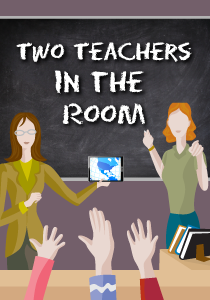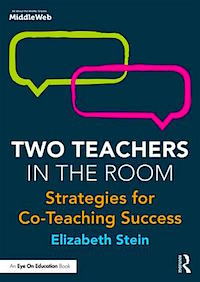The Solution to Inclusion: Small Group Instruction
A MiddleWeb Blog

Over the years and through my travels across the nation, the same question surfaces and re-surfaces: How can I meet the needs of the diverse learners in my care?
With two teachers in the room, this question should be much easier to answer—wouldn’t you think? Yet, too often, teachers continue to spin their wheels trying to find the balance between professional relationships, teaching, assessing, and just plain enjoying the learning process each day.
This post will be dedicated to all those teachers who are looking for solutions to meet the needs of all learners – that means every learner in the room – including the two teachers. Are you ready for the best part? There really is a fine solution just waiting for you to embrace, and it comes down to three simple (yet promising!) words: small group instruction.
Keep your minds open to the pure potentiality of meeting the needs of every learner in your classroom – no matter what grade, content area, or school setting. That’s right! As you keep your mind open throughout reading this post, you will find small group instruction could be the very thing to guide you in designing accessible and meaningful learning and effective outcomes for everyone!
Here’s What We’re Going to Do
This post invites you to do two things. First, read through with an open mind – thinking what could small group learning look like in your classroom. Then…plan at least three lessons between December and March – that’s it – at least three lessons over the next few months.
There is no doubt that after a committed, reflective and action-based process on your part, you will find that small group instruction meets the goal of preparing your students with the real-life, applicable thinking skills they will absolutely need as they move along the grades and onto their career paths. Yes! it can be that powerful!
Why Small Group Instruction?
Let’s get specific about some of the reasons why small group instruction is necessary to meet the needs of diverse learners in any inclusive setting (or any general education classroom for that matter!).
Reason #1: All learners are individuals. We must value their time to think, process, and absorb within the learning moments. Why force them all into the same lesson at the same time—at the same pace? I mean seriously, just think about it. Adults, in any career, must be savvy with communicating, problem-solving, and collaborating in small groups. How are we getting students ready for this?

Reason #2: Scaffolding instruction becomes much more manageable when teachers plan within smaller groups. It’s no longer about how to meet the needs of everyone – the focus shifts to creating the space for students to take ownership and actively participate within the well-designed instruction.
Reason #3: Small group instruction serves to break any lesson down into achievable tasks for constructing knowledge toward mastering the overall learning targets.
The benefits of designing small group instruction are plentiful! For starters, in a co-taught classroom, each teacher has the opportunity to design and actively facilitate learning – rather than one teacher taking charge. Each teacher has the opportunity to share his or her expertise – and life as a co-teacher becomes much more rewarding.
In addition, there are numerous benefits for students. Here are a few very convincing arguments for changing many of your whole class lessons to meaningful small group learning experiences.
Benefits for Learners
- Teachers are in close proximity to work face to face with each student. Student performance and learning outcomes may be closely monitored.
- Students are in their glory! They no longer sit passively in a large group. Rather, they are active learners who actually value their own thinking about the content, and they share their voice – imagine that!
- Learners in small groups are more willing to take risks as they collaborate. Their self-efficacy has the opportunity to rise to new levels of awesome!
- The two teachers in the room have the opportunity to zoom in with a keen focus and timely responsive manner on the needs of small group participants.
Interested to learn more about your next steps? Check out this ASCD link on making formative assessment and meaningful, proactive differentiated instruction a natural outcome of working in small groups. How can you make this happen in your classroom?
Other resources:
“Learning to Love Assessment” (Carol Ann Tomlinson)
“Math Small Group Instruction” (Tyne Brack)
“Co-Teaching in Tandem” (Carol Ann Tomlinson)
Assessment & Success in a Differentiated Classroom (esp. pp 10-13)
How do you already incorporate small group instruction within your daily, weekly, or monthly instruction?
What is one lesson you could design within small groups to meet the needs of all learners in your room?
________________________________________________



































